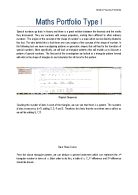In this case, the second difference – the difference between any two consecutive values of the first difference (the difference between consecutive values of ) is calculated, and used to prove that the earlier used method of calculating subsequent values of is reliable.
The sequence has a constant second difference of 1.
∴
∴
∴
∴
When applied to the 5th, 6th, and 7th triangular numbers which hold n values of 5, 6, and 7 accordingly, the equation proves true:
To find, set =
, n = 4
, , → , ,
= 6, = 10
∴
And with the difference between, and (, the value of can be calculated by adding the difference to.
∴ = + 5
= 10 + 5
= 15
To find a general statement that represents in terms of n, it can be observed that in each diagram of triangular numbers, as n increases, the number of levels in the triangular number diagram of n increases as well. 1 3 6 10
Let represent the level in the sequence, and the number of dots in that level. As the very first triangular number has only one level, let represent the first level of any triangular number diagram.
When n = 2, there will be a new level in the triangle, and the levels will add up so that + (the addition of all the dots in the first and second level).
For any number n in the sequence, the number of levels in the diagram for that number would be equivalent to the value of n.
To find, the value of the levels beginning with until can be added together. The sum of the levels
The number of dots in each individual level:
In (the first level), n=1, the number of dots = 1
In (the second level), n=2, the number of dots = 2
In (the third level), n=3, the number of dots = 3
In, n = n, ∴ the number of dots in the level = n
=
=
= → n number of times
=
∴
Cubic Numbers
Considering the set of cubic numbers,,,, …
Let be the cubic number.
The first 10 cubic numbers are:,,,,,,,,,
The value of the each of the first 10 cubic numbers can be found as such:
Since a cubic number is a number to the power of 3, n cubed would be: = = × ×
When = 1, = 1×1×1 = 1
When = 2, = 2×2×2 = 8
When = 3, = 3×3×3 =27
When = 4, = 4×4×4 = 64
When = 5, = 5×5×5 = 125
When = 6, = 6×6×6 = 216
When = 7, = 7×7×7 = 343
When = 8, = 8×8×8 = 512
When = 9, = 9×9×9 = 729
When = 10, = 10×10×10 = 1000
∴
Let be the sum of the first n cubic numbers.
Finding for 1 ≤ n ≤ 10, where n is an integer can be calculated using technology.
Calculating for 1 ≤ n ≤ 10 refers to finding the sum of all cubic numbers where n is greater than or equal to 1, and less than or equal to 10.
→ Calculated with the use of the GDC.
The general statement used to calculate can be found as such:
Assume the function exists such that:
=
=
=
…
=
=
In the function, the cubic number sequence would be the first difference of the terms of the function.
When finding, the sum can also be written as such:
= + + + … + +
= (+ ()+ ()+ … + ()+
(
= - + - + -+ … +- +-
= - + - + -+ … +- +-
= -
This is because when written in the form = (+ ()+ ()+ … + ()+ (, the first term in the first/previous bracket, cancels out the second term in the subsequent bracket, thus leaving only the second term of the first bracket, and the first term of the last bracket, not cancelled.
∴-
Following the assumption that the function exists, and that the sum of the cubic number sequence can be found with it – by finding the function, the sum of the cubic number sequence can be found.
To find a suitable function , consider the general function for a:
Linear Sequence:
Quadratic Sequence:
To pick the appropriate function, consider the following:
Look at a linear sequence → 1, 2, 3, 4, …,
Where =
If
=
Consider:
=
With no n value, the function cannot be used for. As n will be lowered by one degree, the appropriate function would have a polynomial with one more degree than = .
∴ Let
=
=
+
+
+
+
=
When = -
=-
=
= →
+ →
+ →
+ →
+ →
=
Since, the coefficient of must equal 1 so that coefficient) =:
Since only should remain, The remaining coefficients of n ( , and) should equal 0. We can use to solve for , , and
→
→
→
∴
= + + + … + +
= -
=
=
=
=
=
=+
=+
=
=
=
=
=
The validity of the general statement can be tested using technology.
The general statement is valid for all positive values of n (represented on the x-asis).
The scope/limitations of the general statement are as such:
The general statement works for all values of n ≥ 0
The general statement was derived through the method of induction and the formation of conjectures.
The relationship between and can be seen as such:
=
=
=
= , =
This can be verified with the use of technology:
→ Calculated with the use of the GDC and graphmatica.
: :
: :







